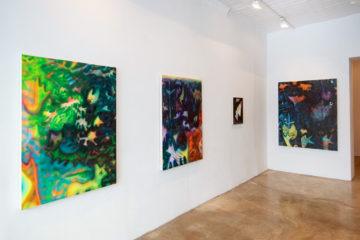Sangram Majumdar interviews Catherine Haggerty at BOMB Magazine:
 SM These thoughts seem to parallel how so many aspects of your paintings live at the edge of becoming or dissolving. There’s a porousness to your world. Does this relate to the title of your show, An Echo’s Glyph, in any way?
SM These thoughts seem to parallel how so many aspects of your paintings live at the edge of becoming or dissolving. There’s a porousness to your world. Does this relate to the title of your show, An Echo’s Glyph, in any way?
CH I teach a Non-European Art Histories class at the School of Visual Arts, and we spend four weeks on Indigenous art and ledger drawing. I have been studying glyphs as a structure to hold meaning and identity. I love the way they float above the protagonist’s head in ledger drawings. I’ve begun to wonder how I can make my own and reference this beautiful and intelligent history in my work. An echo in itself is ephemeral, and it is fleeting. So for an echo to have a glyph, an identity marker actually seems impossible, which interested me for the title of the show. For me, glyphs get created through movement, through work, and through time, whereas Indigenous glyphs are specific and used for identification in pictographs. Ledger glyphs have to be specific, but mine are open and ambiguous which speaks to your comment about the work being porous. Each form has its own life, its own energy; they hover in space and are autonomous, not always connected to a character.
more here.
